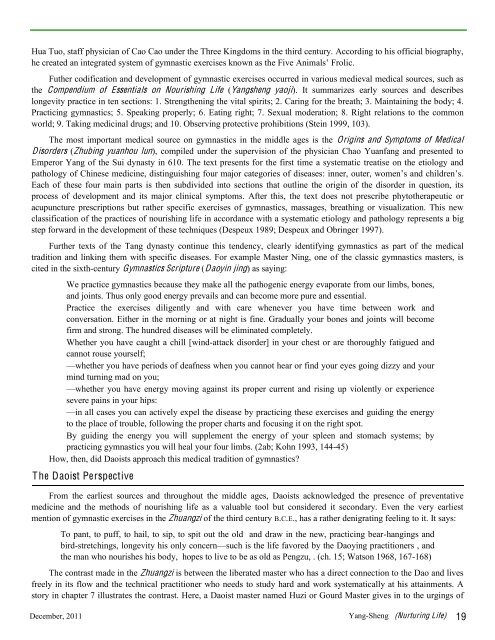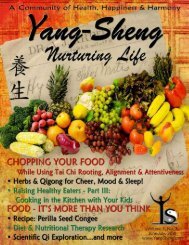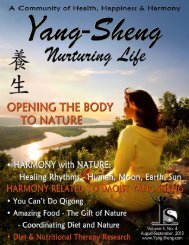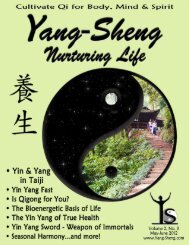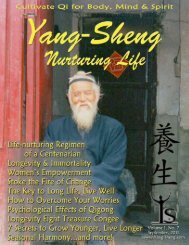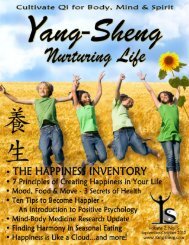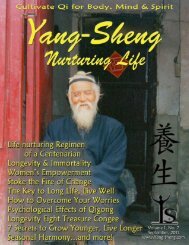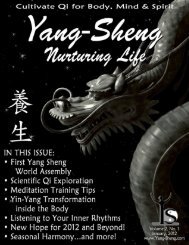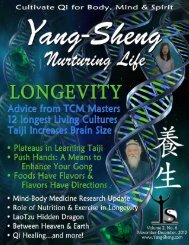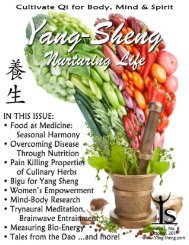Download the December issue of Yang-Sheng as
Download the December issue of Yang-Sheng as
Download the December issue of Yang-Sheng as
You also want an ePaper? Increase the reach of your titles
YUMPU automatically turns print PDFs into web optimized ePapers that Google loves.
Hua Tuo, staff physician <strong>of</strong> Cao Cao under <strong>the</strong> Three Kingdoms in <strong>the</strong> third century. According to his <strong>of</strong>ficial biography,<br />
he created an integrated system <strong>of</strong> gymn<strong>as</strong>tic exercises known <strong>as</strong> <strong>the</strong> Five Animals’ Frolic.<br />
Fu<strong>the</strong>r codification and development <strong>of</strong> gymn<strong>as</strong>tic exercises occurred in various medieval medical sources, such <strong>as</strong><br />
<strong>the</strong> Compendium <strong>of</strong> Essentials on Nourishing Life (<strong>Yang</strong>sheng yaoji). It summarizes early sources and describes<br />
longevity practice in ten sections: 1. Streng<strong>the</strong>ning <strong>the</strong> vital spirits; 2. Caring for <strong>the</strong> breath; 3. Maintaining <strong>the</strong> body; 4.<br />
Practicing gymn<strong>as</strong>tics; 5. Speaking properly; 6. Eating right; 7. Sexual moderation; 8. Right relations to <strong>the</strong> common<br />
world; 9. Taking medicinal drugs; and 10. Observing protective prohibitions (Stein 1999, 103).<br />
The most important medical source on gymn<strong>as</strong>tics in <strong>the</strong> middle ages is <strong>the</strong> Origins and Symptoms <strong>of</strong> Medical<br />
Disorders (Zhubing yuanhou lun), compiled under <strong>the</strong> supervision <strong>of</strong> <strong>the</strong> physician Chao Yuanfang and presented to<br />
Emperor <strong>Yang</strong> <strong>of</strong> <strong>the</strong> Sui dyn<strong>as</strong>ty in 610. The text presents for <strong>the</strong> first time a systematic treatise on <strong>the</strong> etiology and<br />
pathology <strong>of</strong> Chinese medicine, distinguishing four major categories <strong>of</strong> dise<strong>as</strong>es: inner, outer, women’s and children’s.<br />
Each <strong>of</strong> <strong>the</strong>se four main parts is <strong>the</strong>n subdivided into sections that outline <strong>the</strong> origin <strong>of</strong> <strong>the</strong> disorder in question, its<br />
process <strong>of</strong> development and its major clinical symptoms. After this, <strong>the</strong> text does not prescribe phyto<strong>the</strong>rapeutic or<br />
acupuncture prescriptions but ra<strong>the</strong>r specific exercises <strong>of</strong> gymn<strong>as</strong>tics, m<strong>as</strong>sages, breathing or visualization. This new<br />
cl<strong>as</strong>sification <strong>of</strong> <strong>the</strong> practices <strong>of</strong> nourishing life in accordance with a systematic etiology and pathology represents a big<br />
step forward in <strong>the</strong> development <strong>of</strong> <strong>the</strong>se techniques (Despeux 1989; Despeux and Obringer 1997).<br />
Fur<strong>the</strong>r texts <strong>of</strong> <strong>the</strong> Tang dyn<strong>as</strong>ty continue this tendency, clearly identifying gymn<strong>as</strong>tics <strong>as</strong> part <strong>of</strong> <strong>the</strong> medical<br />
tradition and linking <strong>the</strong>m with specific dise<strong>as</strong>es. For example M<strong>as</strong>ter Ning, one <strong>of</strong> <strong>the</strong> cl<strong>as</strong>sic gymn<strong>as</strong>tics m<strong>as</strong>ters, is<br />
cited in <strong>the</strong> sixth-century Gymn<strong>as</strong>tics Scripture (Daoyin jing) <strong>as</strong> saying:<br />
We practice gymn<strong>as</strong>tics because <strong>the</strong>y make all <strong>the</strong> pathogenic energy evaporate from our limbs, bones,<br />
and joints. Thus only good energy prevails and can become more pure and essential.<br />
Practice <strong>the</strong> exercises diligently and with care whenever you have time between work and<br />
conversation. Ei<strong>the</strong>r in <strong>the</strong> morning or at night is fine. Gradually your bones and joints will become<br />
firm and strong. The hundred dise<strong>as</strong>es will be eliminated completely.<br />
Whe<strong>the</strong>r you have caught a chill [wind-attack disorder] in your chest or are thoroughly fatigued and<br />
cannot rouse yourself;<br />
—whe<strong>the</strong>r you have periods <strong>of</strong> deafness when you cannot hear or find your eyes going dizzy and your<br />
mind turning mad on you;<br />
—whe<strong>the</strong>r you have energy moving against its proper current and rising up violently or experience<br />
severe pains in your hips:<br />
—in all c<strong>as</strong>es you can actively expel <strong>the</strong> dise<strong>as</strong>e by practicing <strong>the</strong>se exercises and guiding <strong>the</strong> energy<br />
to <strong>the</strong> place <strong>of</strong> trouble, following <strong>the</strong> proper charts and focusing it on <strong>the</strong> right spot.<br />
By guiding <strong>the</strong> energy you will supplement <strong>the</strong> energy <strong>of</strong> your spleen and stomach systems; by<br />
practicing gymn<strong>as</strong>tics you will heal your four limbs. (2ab; Kohn 1993, 144-45)<br />
How, <strong>the</strong>n, did Daoists approach this medical tradition <strong>of</strong> gymn<strong>as</strong>tics?<br />
The Daoist Perspective<br />
From <strong>the</strong> earliest sources and throughout <strong>the</strong> middle ages, Daoists acknowledged <strong>the</strong> presence <strong>of</strong> preventative<br />
medicine and <strong>the</strong> methods <strong>of</strong> nourishing life <strong>as</strong> a valuable tool but considered it secondary. Even <strong>the</strong> very earliest<br />
mention <strong>of</strong> gymn<strong>as</strong>tic exercises in <strong>the</strong> Zhuangzi <strong>of</strong> <strong>the</strong> third century B.C.E., h<strong>as</strong> a ra<strong>the</strong>r denigrating feeling to it. It says:<br />
To pant, to puff, to hail, to sip, to spit out <strong>the</strong> old and draw in <strong>the</strong> new, practicing bear-hangings and<br />
bird-stretchings, longevity his only concern—such is <strong>the</strong> life favored by <strong>the</strong> Daoying practitioners , and<br />
<strong>the</strong> man who nourishes his body, hopes to live to be <strong>as</strong> old <strong>as</strong> Pengzu, . (ch. 15; Watson 1968, 167-168)<br />
The contr<strong>as</strong>t made in <strong>the</strong> Zhuangzi is between <strong>the</strong> liberated m<strong>as</strong>ter who h<strong>as</strong> a direct connection to <strong>the</strong> Dao and lives<br />
freely in its flow and <strong>the</strong> technical practitioner who needs to study hard and work systematically at his attainments. A<br />
story in chapter 7 illustrates <strong>the</strong> contr<strong>as</strong>t. Here, a Daoist m<strong>as</strong>ter named Huzi or Gourd M<strong>as</strong>ter gives in to <strong>the</strong> urgings <strong>of</strong><br />
<strong>December</strong>, 2011 <strong>Yang</strong>-<strong>Sheng</strong> (Nurturing Life) 19


